Health Care > QUESTIONS & ANSWERS > Abdominal Final Review WCUI 2022 with complete solution (All)
Abdominal Final Review WCUI 2022 with complete solution
Document Content and Description Below
Abdominal Final Review WCUI 2022 with complete solution The kidney is divided into what two regions? -Answer- The renal sinus and the renal parenchyma What is the renal sinus? -Answer- The collect... ing system What is the renal parenchyma? -Answer- The functional part of the kidney which includes the renal cortex and renal medulla What is the renal cortex? -Answer- The outer band of tissue in the kidney What is the renal medulla composed of? -Answer- Medulla/renal pyramids How does the renal cortex appear on ultrasound? -Answer- Homogeneous and slightly hypoechoic than a normal liver What are cortical extensions in between the medullary pyramids called? -AnswerColumns of Bertin True or False? The columns of Bertin project towards the renal sinus -Answer- True How do the medullary pyramids appear on ultrasound? -Answer- Relatively hypoechoic round or triangular areas between the cortex and the renal sinus. What are three junctions or sites of connection in the upper and lower urinary systems? -Answer- 1. UPJ - ureteropelvic junction 2. UVJ - ureterovesical junction 3. VUJ -vesicourethral junction What is the most common site of obstruction due to a stone in the urinary system? - Answer- UVJ- ureterovesical junction What are the ureters? -Answer- Thin muscular tubes that are 25-30 cm long, 4-7 mm in diameter Where do the ureters originate? -Answer- The ureteropelvic junction How do the ureters course? -Answer- -They course through the retroperitoneum until the ureterovesical junction -At this level, they pass obliquely through the muscular bladder wall, creating a valve mechanism that prevents urine reflux What is ureteral peristalsis? -Answer- It transports urine to the urinary bladderWhat is associated with the bladder? -Answer- -Large muscular bag -Has postero-lateral openings for the ureters -Has an anterior opening for the urethra Urine collects and contracts to expel urine through the ________, conveys urine from the Urinary Bladder to the outside -Answer- Urethra What is the urethra? -Answer- Membranous Hollow Canal, measure 4-6mm What is associated with the junctional parenchyma defect? -Answer- -Seen in upper to mid pole as an echogenic triangular, linear structure -Better seen in the longitudinal plane -May mimic an echogenic mass A simple ectopia is more often seen where? -Answer- The pelvis A horseshoe kidney is also called what? -Answer- Renal fusion What is a horseshoe kidney? -Answer- When two kidneys are fused or joined together What should be seen on ultrasound with a horseshoe kidney? -Answer- -Isthmus should be imaged with ultrasound to confirm the diagnosis -Isthmus is seen midline lower abdomen over the great vessels -In some cases, loss of normal renal outline or reniform, instead they look with some degree of rotation or malrotation What type of horseshoe kidney is the most common? -Answer- The one where the lower poles fuse together How does a complete duplication of a collecting system appear on ultrasound? - Answer- -Two echogenic regions separated by parenchymal tissue -2 separate collecting systems in one kidney The duplicated ureter commonly has a stenotic opening into the bladder and forms what? -Answer- A ureterocele How does a duplex collecting system appear on ultrasound in a transverse imaging plane? -Answer- No echogenic renal pelvis seen on a transverse view at the level of the mid pole What is associated with a parapelvic cyst? -Answer- -Originates from renal parenchyma and seen in the renal hilum -May present with hypertensionWhat are the sonographic findings of a parapelvic cyst? -Answer- -Same criteria as for simple cyst but located within the renal pelvis -Solitary and large -Does not communicate with collecting system Where does a peripelvic cyst originate? -Answer- In the renal sinus from the lymphatic system What are the sonographic findings of a peripelvic cyst? -Answer- -Small, multiple, and irregular in shape -May appear as dilated pelvis -Does not communicate with collecting system What are posterior urethral valves (PUV)? -Answer- Obstructive membranes that develop in the urethra (the tube that drains urine from the bladder) and are most commonly seen in boys What valve can obstruct or block the outflow of urine through the urethra? -AnswerPosterior urethra valve (PUV) What is a copum? -Answer- Extra tissue in the distal urethra What are the sonographic findings for posterior urethra valve (PUV)? -Answer- -The bladder has a distinct "keyhole" appearance and massive bladder, hydroureters, and hydronephrosis -Bilateral hydronephrosis What are the procedures to fix the condition of a posterior urethra valve? -AnswerAblation and vesicostomy What are other names for adult polycystic kidney disease (APKD)? -Answer- Autosomal dominant polycystic kidney disease (ADPKD) or Potter type III What is adult polycystic kidney disease (APKD)? -Answer- -An autosomal dominant disease and the most common disorder. -The disease may be latent for many years and not manifest itself until the fourth decade. What are the clinical findings associated with adult polycystic kidney disease? -Answer- -Patients present with decreasing renal function, and hypertension -May have flank pain -Associated findings include cysts in the liver, pancreas, and spleen. What are the sonographic findings of adult polycystic kidney disease? -AnswerPresents as bilateral large kidneys with randomly distributed cortical cysts of various sizes, and in the advanced stages, the kidneys lose the reniform shape.What is multicystic dysplastic kidney disease? -Answer- -The most common form of the cystic disease in neonates -It can be either dominant or recessive. Juvenile onset is autosomal recessive and adult-onset is autosomal dominant. -Clinically, patients present with renal failure. What are the sonographic findings for multicystic dysplastic kidney disease? -Answer- - There are small cysts in the medullary portion of both kidneys with a decreased definition between the cortical/medulla junctions. -May be uni- or bilateral What are other names for infantile polycystic kidney disease (IPKD)? -AnswerAutosomal recessive polycystic disease (ARPKD) or (Potter type I) What is the least common and most fatal of the three cystic diseases? -AnswerInfantile polycystic kidney disease What is infantile polycystic kidney disease? -Answer- It is an autosomal recessive trait and is more common in females (2:1). With infantile polycystic kidney disease, if survival past infancy occurs what happens? - Answer- Hepatic fibrosis becomes a complication, with death resulting from hepatic failure and/or bleeding from esophageal varices What are the sonographic findings for infantile polycystic kidney disease? -Answer- It presents as bilateral echogenic, enlarged kidneys with cysts with a loss of corticomedullary junction (the cysts classically are too small to be resolved). What is pyonephrosis? -Answer- Pus in the dilated collecting system, a complication of the hydronephrosis, urinary stasis, or infection What are the clinical signs associated with pyonephrosis? -Answer- Similar to an abscess, typically associated with elevated white blood cells count, fever, chills, and flank pain, although some patients may be asymptomatic What are the sonographic findings of pyonephrosis? -Answer- The collecting system is seen as dilated with debris, and often shifting debris-urine level What are the two major classifications of hydronephrosis? -Answer- Intrinsic and extrinsic hydronephrosis Intrinsic hydronephrosis is a result of what? -Answer- -Stricture -Renal calculi (most common site ureterovesical junction) -Bleeding or blood clot -Ureterocele-Pyonephrosis -Tuberculosis of the genitourinary system Extrinsic hydronephrosis is a result of what? -Answer- -Pregnancy -Pelvic masses -Bladder neck obstruction -Trauma -Retroperitoneal fibrosis -Prostatic hypertrophy -Urethritis -Inflammatory lesions -Neurogenic bladder What is a neurogenic bladder? -Answer- The loss of control of the bladder due to damage to a neural network What is a hydroureter? -Answer- It refers to abnormal dilation (>3 mm) of the ureter and may occur in combination with hydronephrosis How does nephrolithiasis appear on ultrasound? -Answer- Renal calculi appear as highly reflective echogenic foci with shadowing. The ________ is a color artifact that has been seen with urinary stones. -Answer- "Twinkle sign" What is a staghorn calculus? -Answer- A large stone located in the central portion of the kidney, the collecting system, and takes the shape of the calyces and renal pelvis What is a medullary sponge kidney (MSK)? -Answer- -A developmental anomaly that occurs in the medullary pyramids and consists of cystic or fusiform dilation of the distal collecting ducts (ducts of Bellini), causing stasis of urine and stone formation. -Associated with hypercalcemia What is tuberous sclerosis? -Answer- An autosomal dominant genetic disorder characterized by mental retardation, seizures, and adenoma sebaceous The renal pathologies most commonly seen in TSC are what? -AnswerAngiomyolipoma, renal cysts, and less commonly, oncocytomas True or False? Tuberous sclerosis may be difficult to separate from adult polycystic kidney disease -Answer- True What is Emphysematous pyelonephritis? -Answer- It refers to a morbid infection with gas formation within or around the kidneys.Emphysematous pyelonephritis commonly occurs in patients who are what? -Answer- In diabetics (87-97% of patients), immunosuppressed patients, and patients with urinary tract obstructions What are the sonographic findings of emphysematous pyelonephritis? -AnswerAnaerobic bacteria produce intrarenal gas causing reverberation or comet tail, or dirty shadowing artifact. What is usually required to treat emphysematous pyelonephritis? -AnswerNephrectomy What is associated with angiomyolipomas? -Answer- -More common benign tumor and most common in women (2:1) -Symptoms are flank pain, hematuria, and hypertension What is the sonographic finding of an angiomyolipoma? -Answer- Discrete highly echogenic mass found in the cortex What is associated with Wilm's Tumor (Nephroblastoma)? -Answer- -Most common primary renal malignancy in children -Abdominal mass, hypertension, and nausea -Hematuria What is the sonographic appearance of Wilm's tumor? -Answer- -Early on - encapsulated, later on, it may extend into the perirenal area -Varied sonographic appearance depending upon the amount of necrosis and hemorrhage What are the clinical findings for Hypernephroma - Adenocarcinoma- Renal Cell Carcinoma (RCC) and Grawitz tumor? -Answer- -Affect males more, after 50 -Hematuria -Hyperperfusion seen on angiogram -Metastases to bone, heart, and brain What are the sonographic findings for Hypernephroma - Adenocarcinoma- Renal Cell Carcinoma (RCC) and Grawitz tumor? -Answer- -Unilateral, solitary, encapsulated -Varied echogenicity, from hypoechoic to hyperechoic -Look for metastatic renal vein/vena cava invasion and thrombosis -Look for the invasion to the contralateral side, ureter, peritoneum, spleen What is associated with acute pyelonephritis? -Answer- -Infection is the most common disease of the urinary tract, and the combination of parenchymal, caliceal, and pelvic inflammation constitutes pyelonephritis. ---Bacteria ascending from the urinary bladder or adjacent lymph nodes to the kidney usually cause infection of the kidney. What is one of the clinical symptoms of acute pyelonephritis? -Answer- BacteriuriaWhat is cystitis? -Answer- Infection or inflammation of the bladder of the lower urinary tract What is the sonographic appearance for cystitis? -Answer- Bladder wall thickening and debris True or False? With primary malignant tumors, 95% are transitional cell carcinoma (TCC) and 5% are squamous cell carcinoma -Answer- True What is associated with primary malignant bladder tumors? -Answer- -Invasive tumor -40% will metastasize into the prostate and pelvic organs -Usually detected late in the stage -Hematuria, dysuria, anuria, urinary frequency What are bladder/ureteral stones? -Answer- They can develop in the bladder or form in the kidney and travel down through the ureters What is the sonographic appearance of bladder/ureteral stones? -Answer- Echogenic focus with posterior acoustic shadowing. What is a urinary bladder diverticulum? -Answer- -An outpouching from the bladder wall. -It may be solitary or multiple in nature and can vary considerably in size. -It can be congenital or acquired. What is renal failure? -Answer- -It is the kidneys' inability to filter metabolites from the blood resulting in decreased renal function -It may be either acute or chronic What laboratory findings are associated with renal failure? -Answer- Increased serum BUN and serum creatinine levels What are the sonographic findings of acute renal failure? -Answer- -The kidney may be normal-sized or enlarged -There may be decreased definition between the medullary/cortical junctions What are the sonographic findings of chronic renal failure? -Answer- -The echogenicity will increase -Patients in end-stage renal failure will have small echogenic kidneys that are difficult to image Sonographically. What is the location of the adrenal glands? -Answer- Suprarenal space What are the adrenal glands and kidneys enclosed by? -Answer- Gerota's fasciaThe adrenal cortex produces steroid hormones which are? -Answer- Aldosterone, cortisol, and gonadocorticoids What is aldosterone? -Answer- Used to regulate electrolyte metabolism What is cortisol? -Answer- An antistress and anti-inflammatory hormone What is gonadocorticoids? -Answer- Used for regulation of the secretion of androgens and estrogens, which are the sex hormones of an individual The adrenal medulla produces what? -Answer- Epinephrine and norepinephrine What is epinephrine? -Answer- -It dilates the coronary vessels and constricts the skin and kidney vessels. -It increases coronary output, raises oxygen consumption, and causes hyperglycemia. What is nonepinephrine? -Answer- -It constricts all arterial vessels except the coronary arteries (which dilate). -It is the essential regulator of blood pressure. What are the clinical findings for Adrenocortical Hyperfunction (Cushing's Syndrome)? - Answer- Cortisol ↑ and adrenal androgens- diabetes, large abdomen, loss of tissue's elasticity, cardiomegaly, edema, hirsutism, amenorrhea What are the clinical findings for Conn's syndrome? -Answer- Aldosterone ↑ - associated with sodium retention, hence hypertension, increased thirst, and urination What are the clinical findings for Adrenocortical Hypofunction - Addison's disease? - Answer- -Hormonal production ↓ - causing hypotension weight loss, skin pigmentation, loss of hair, menstrual dysfunction -Autoimmune predominantly (80%) What is the most common benign tumor of the adrenal glands? -Answer- Adenomas What are the clinical findings of adenomas? -Answer- -Benign tumors associated with Cushing's and Conn's syndromes (hyperproduction of hormones) -In most of the cases - asymptomatic What are the sonographic findings of adenomas? -Answer- Round or oval in shape mass, usually larger than 1 cm, hypoechoic lesion [Show More]
Last updated: 1 year ago
Preview 1 out of 15 pages

Reviews( 0 )
Document information
Connected school, study & course
About the document
Uploaded On
Jan 09, 2023
Number of pages
15
Written in
Additional information
This document has been written for:
Uploaded
Jan 09, 2023
Downloads
0
Views
138



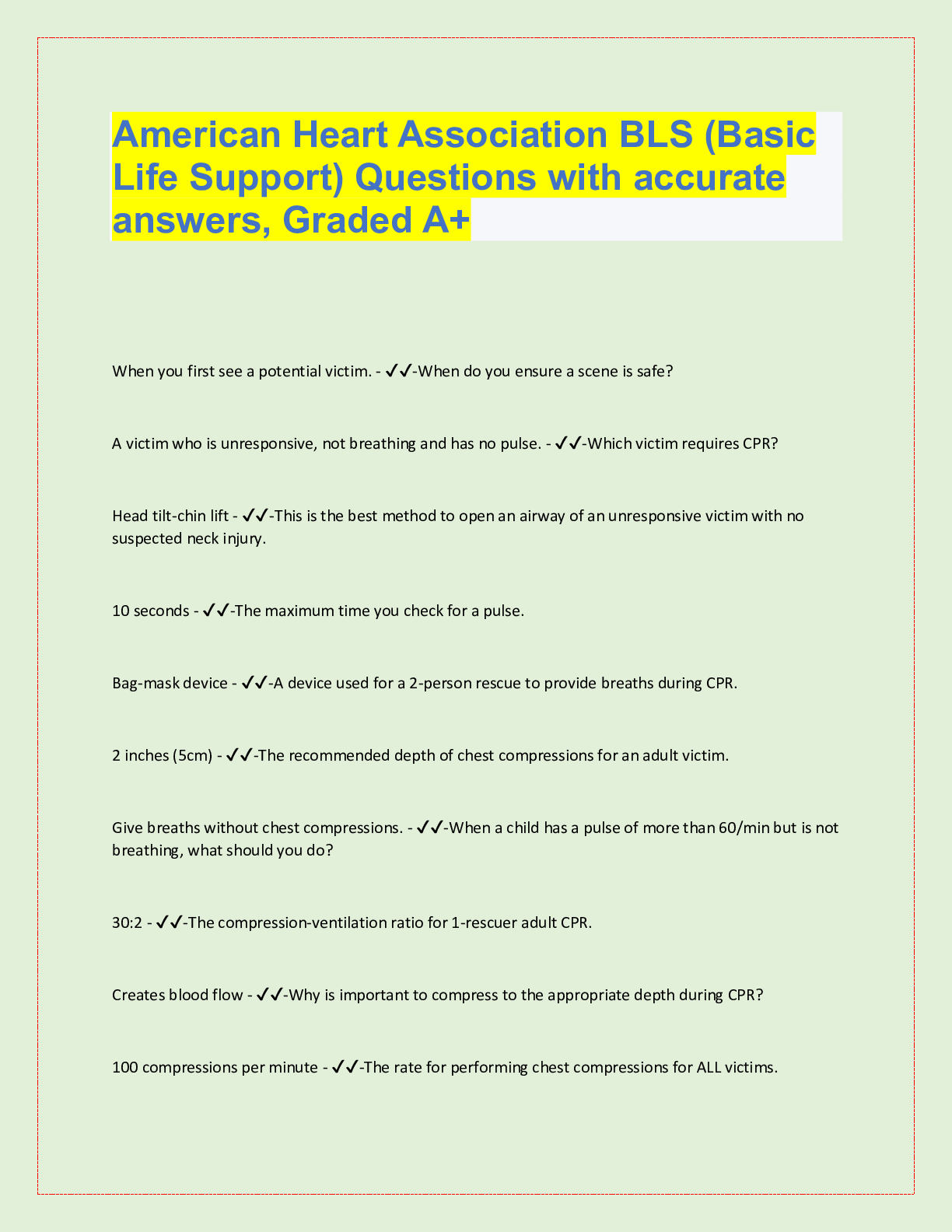


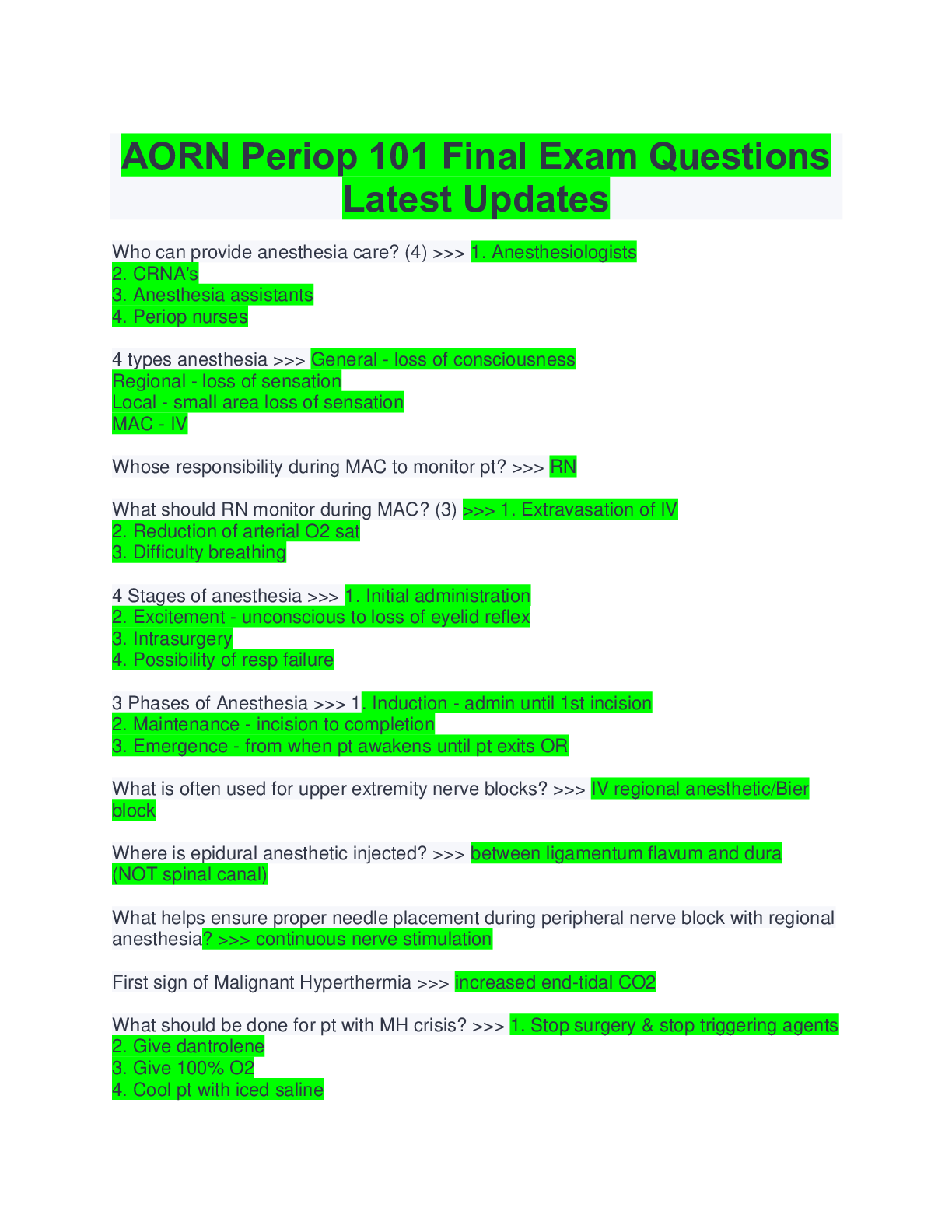









.png)
.png)



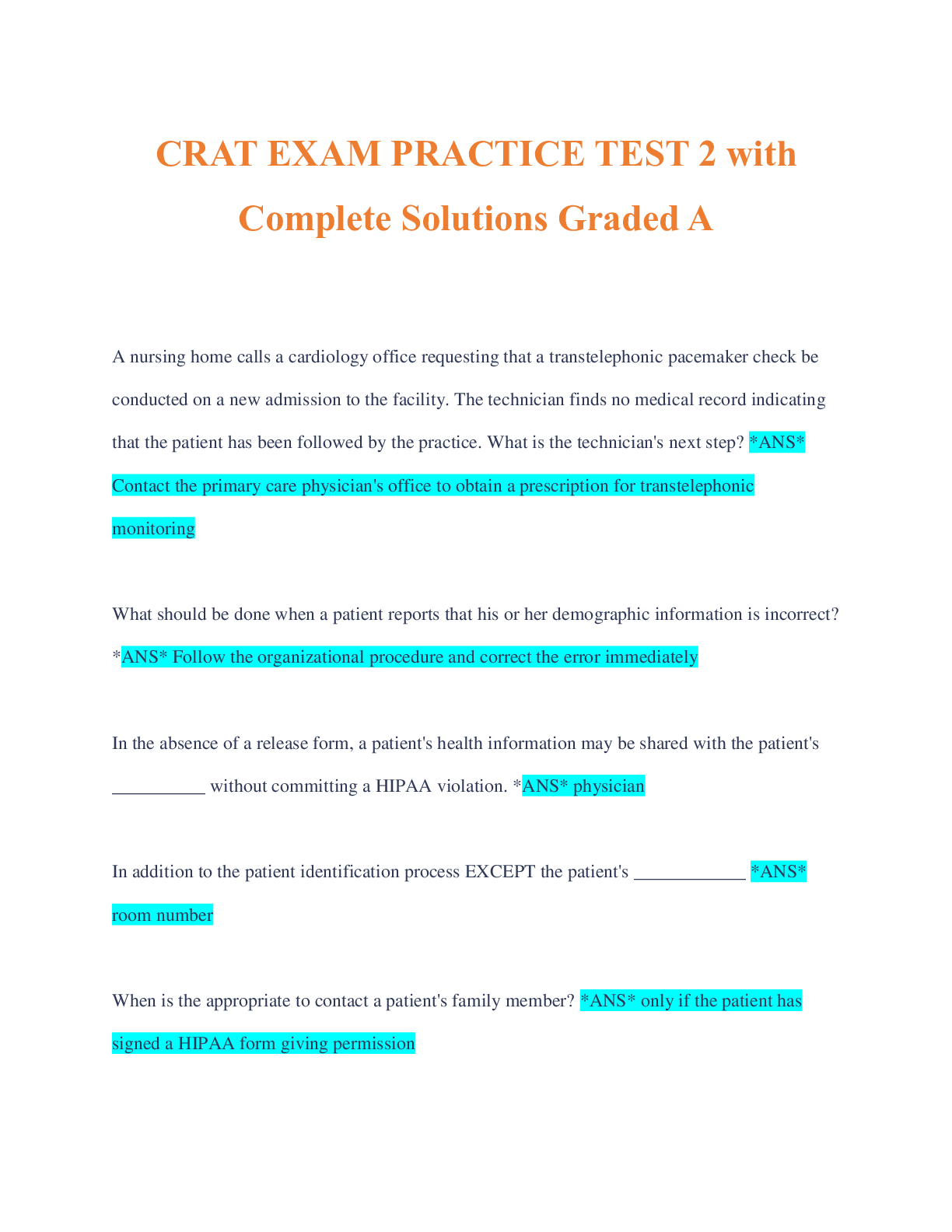
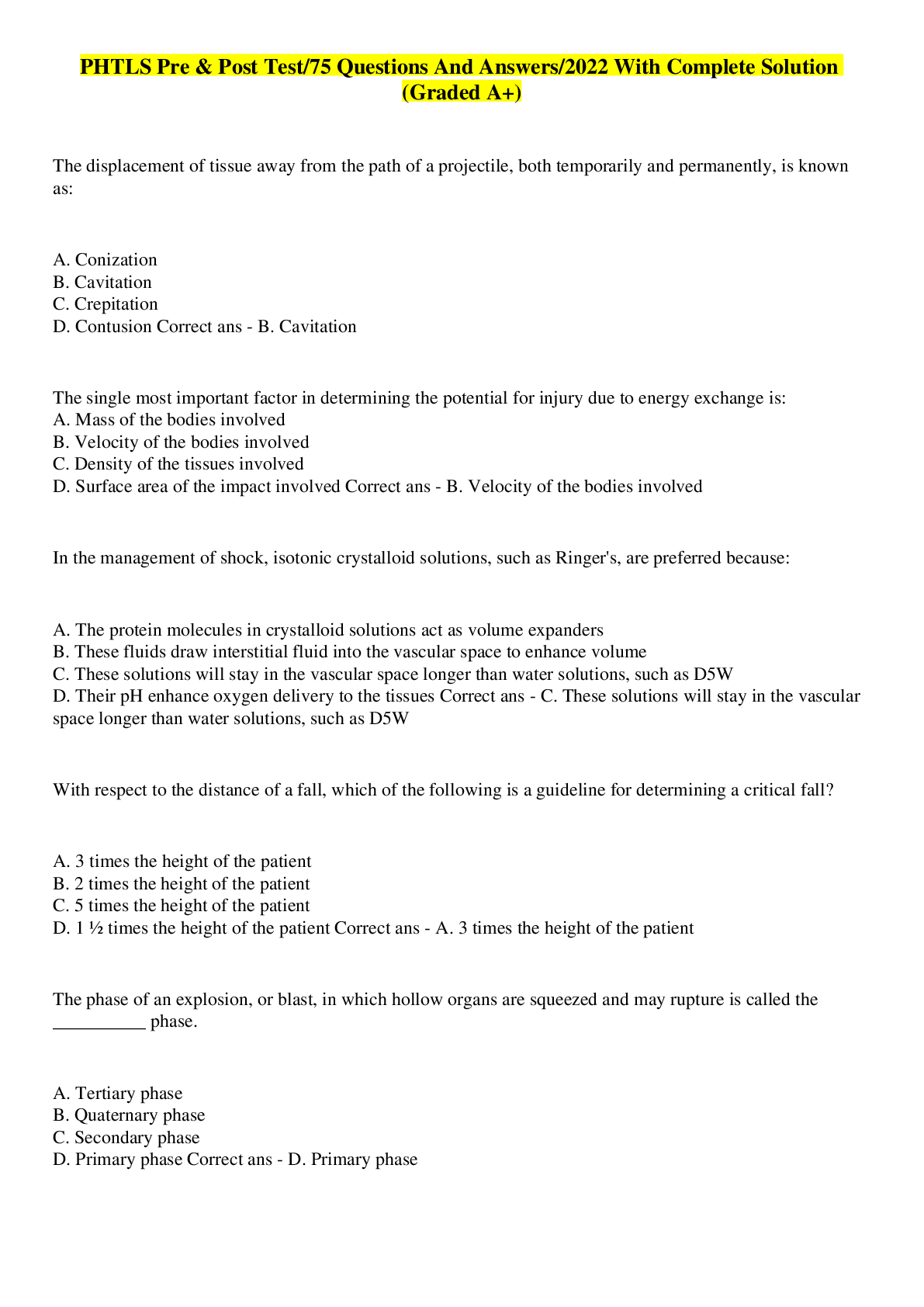
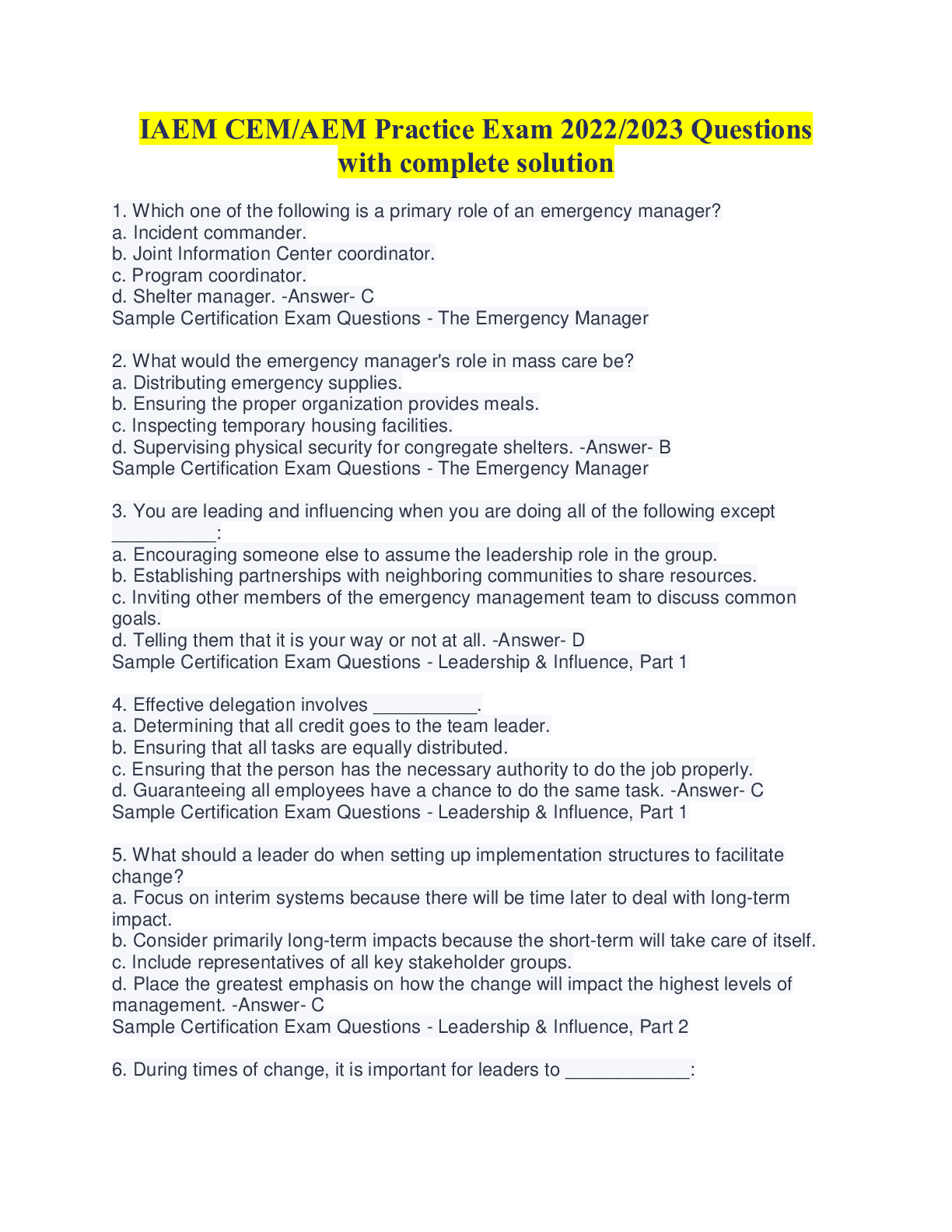
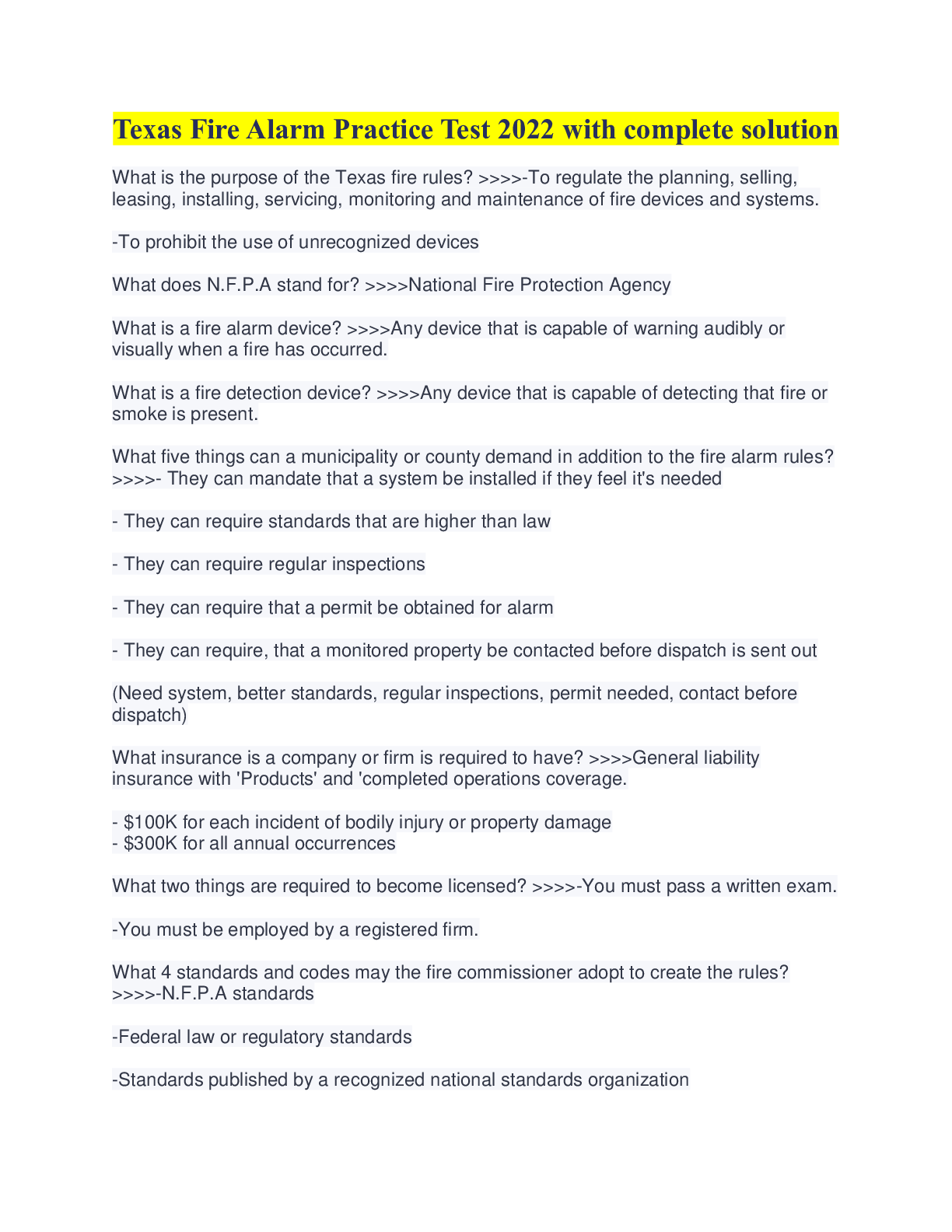
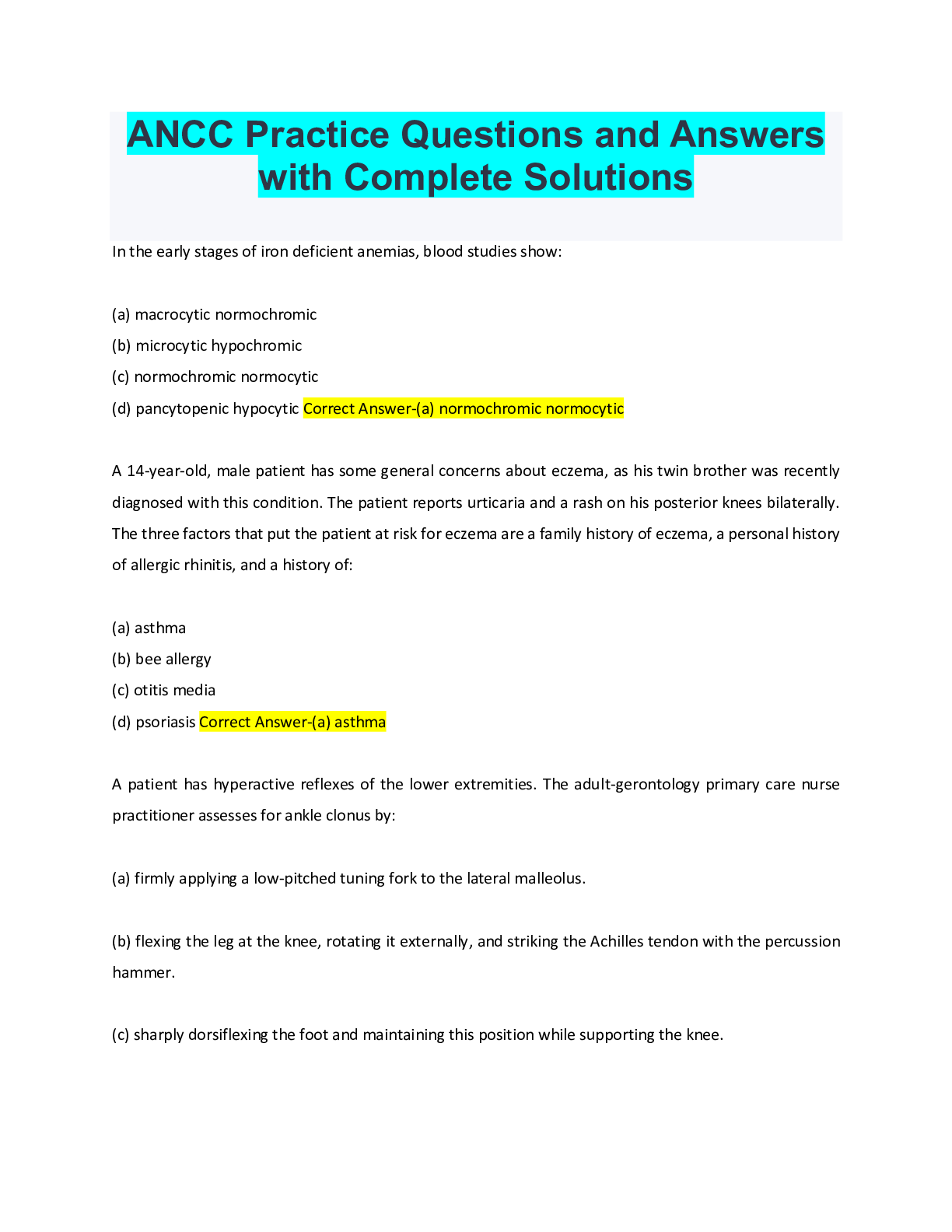
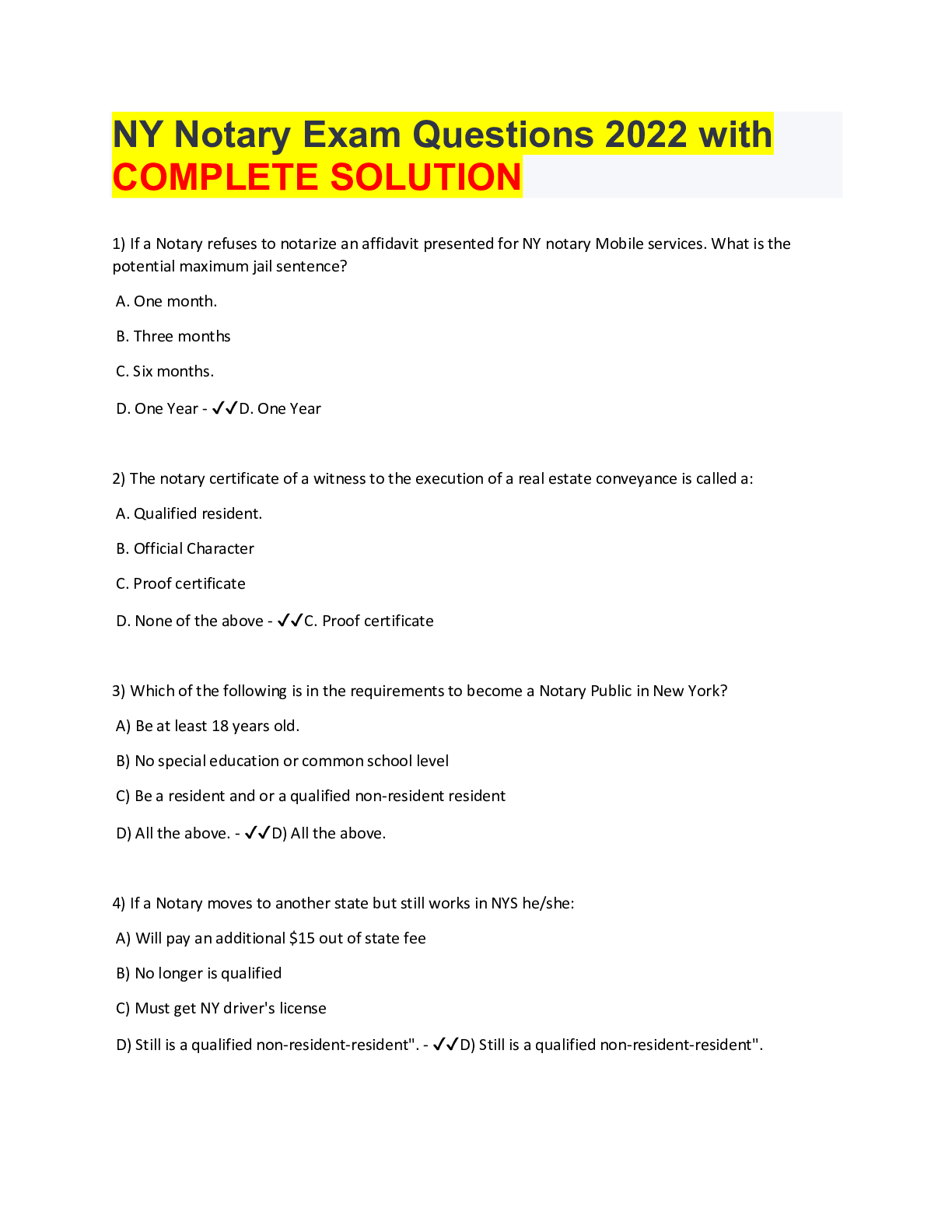
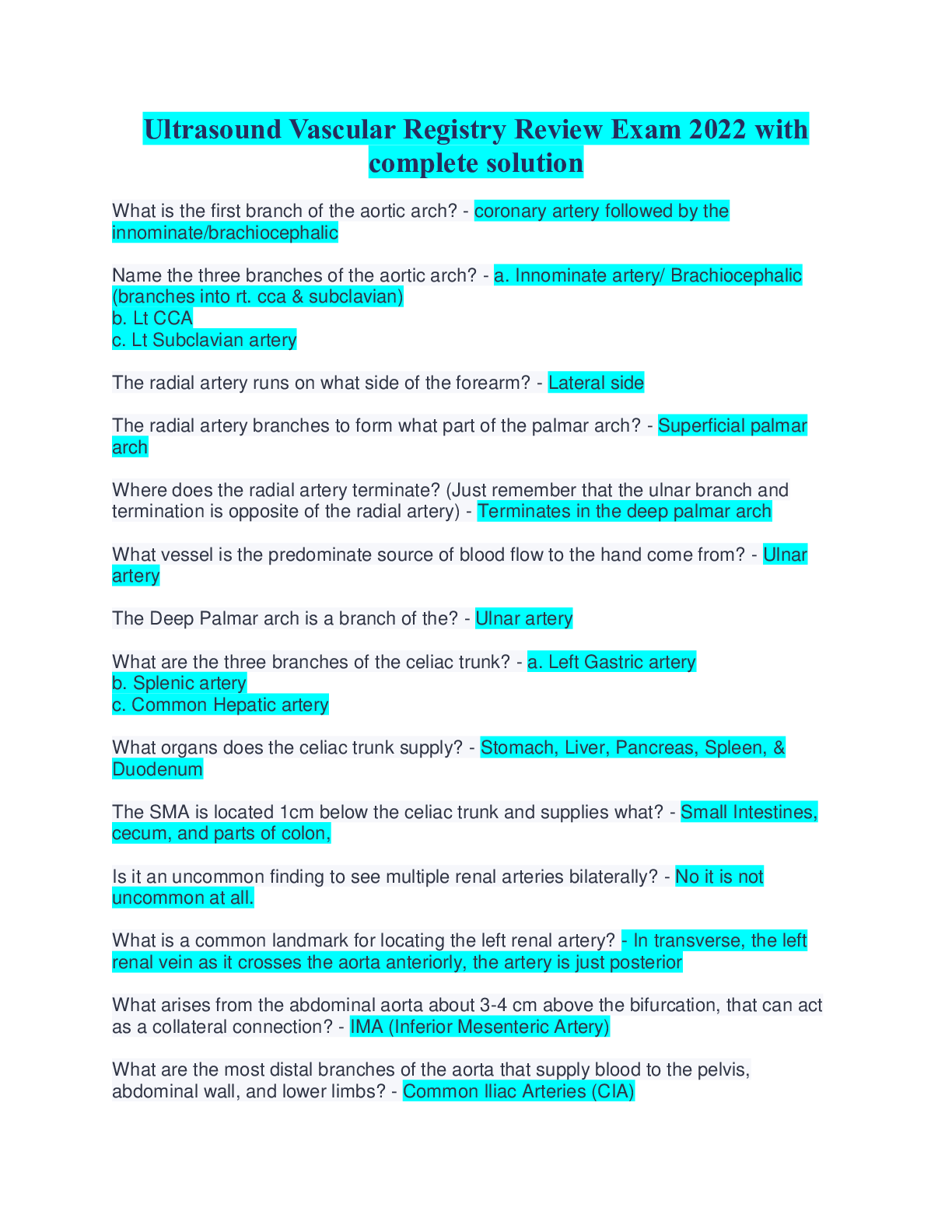
.png)

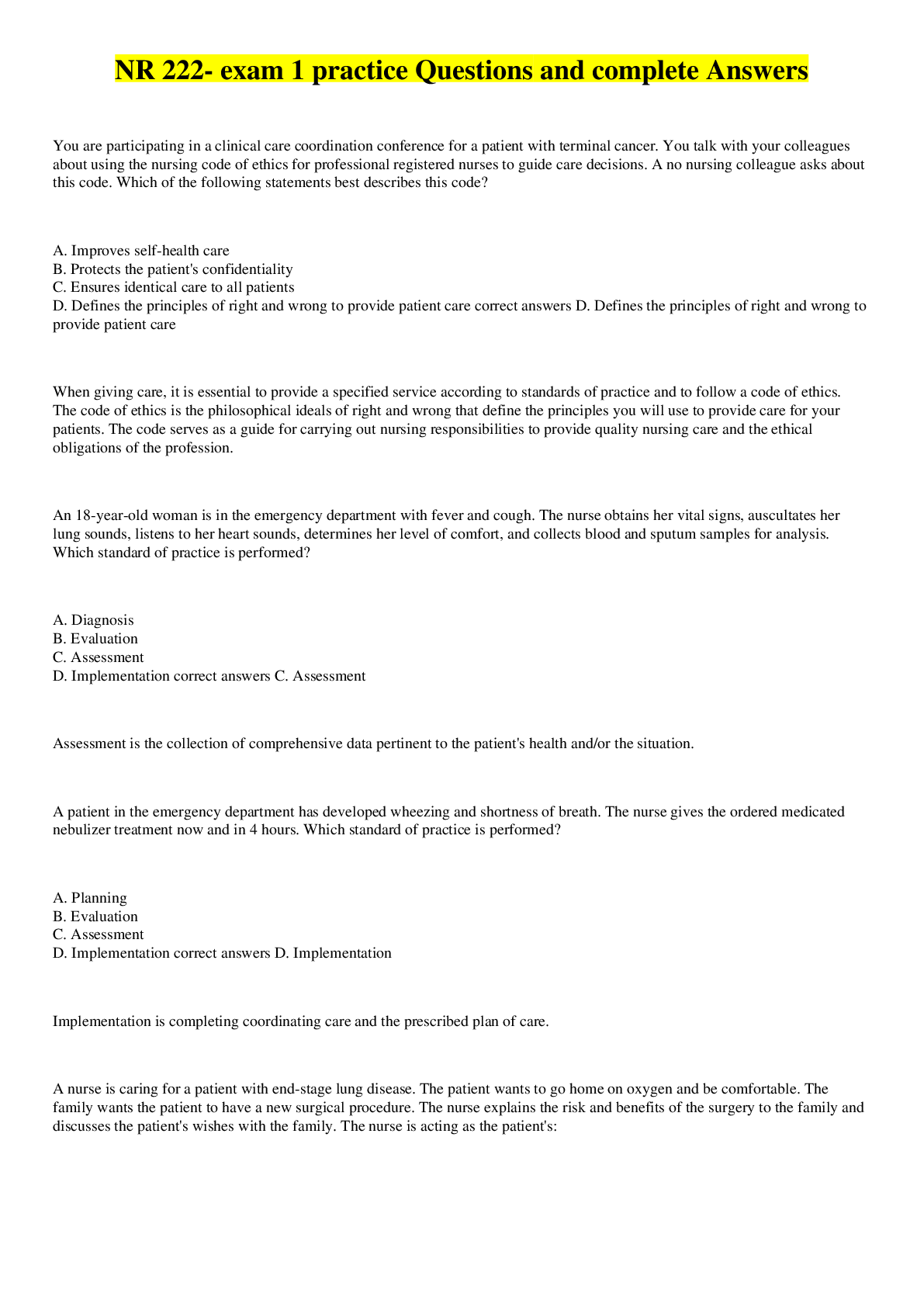
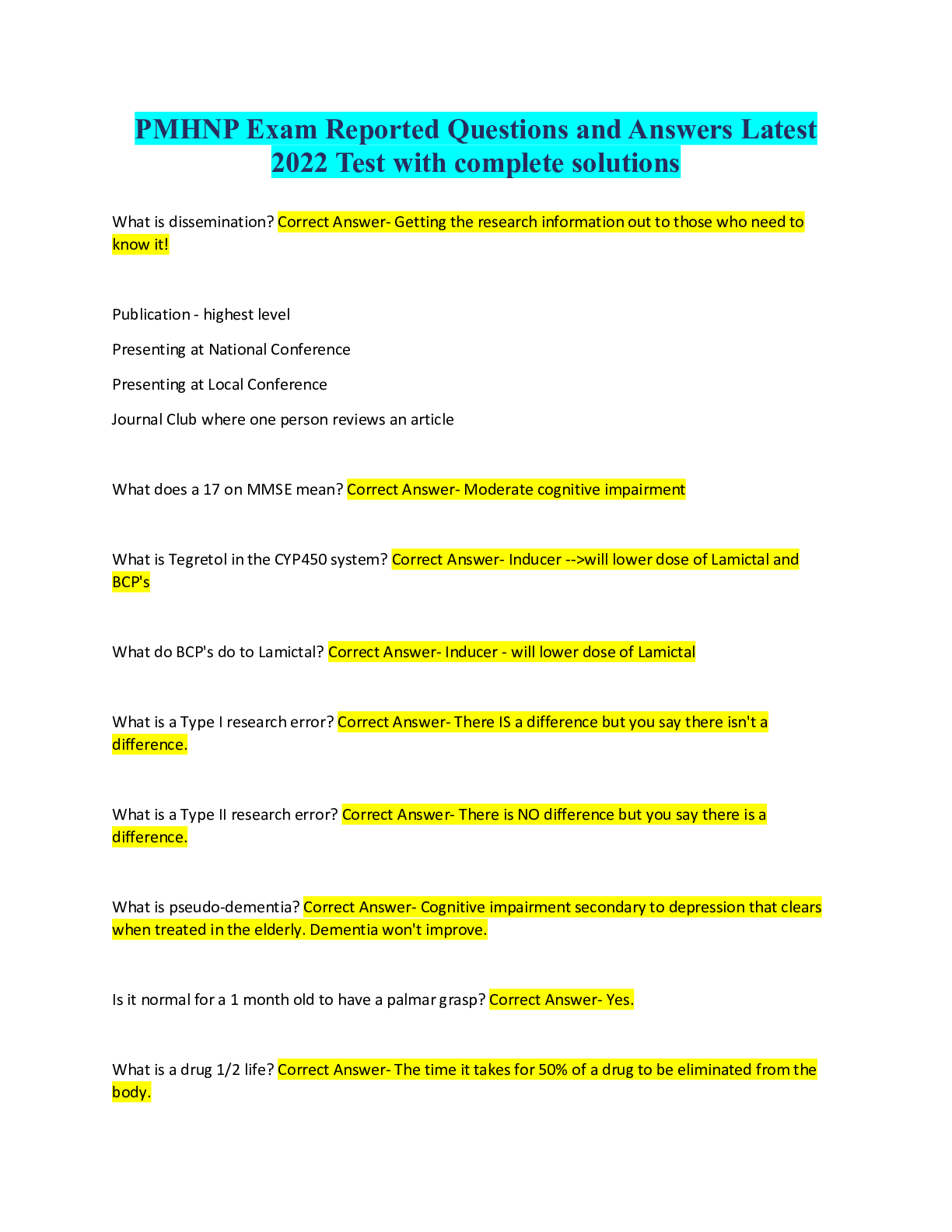
.png)
.png)

